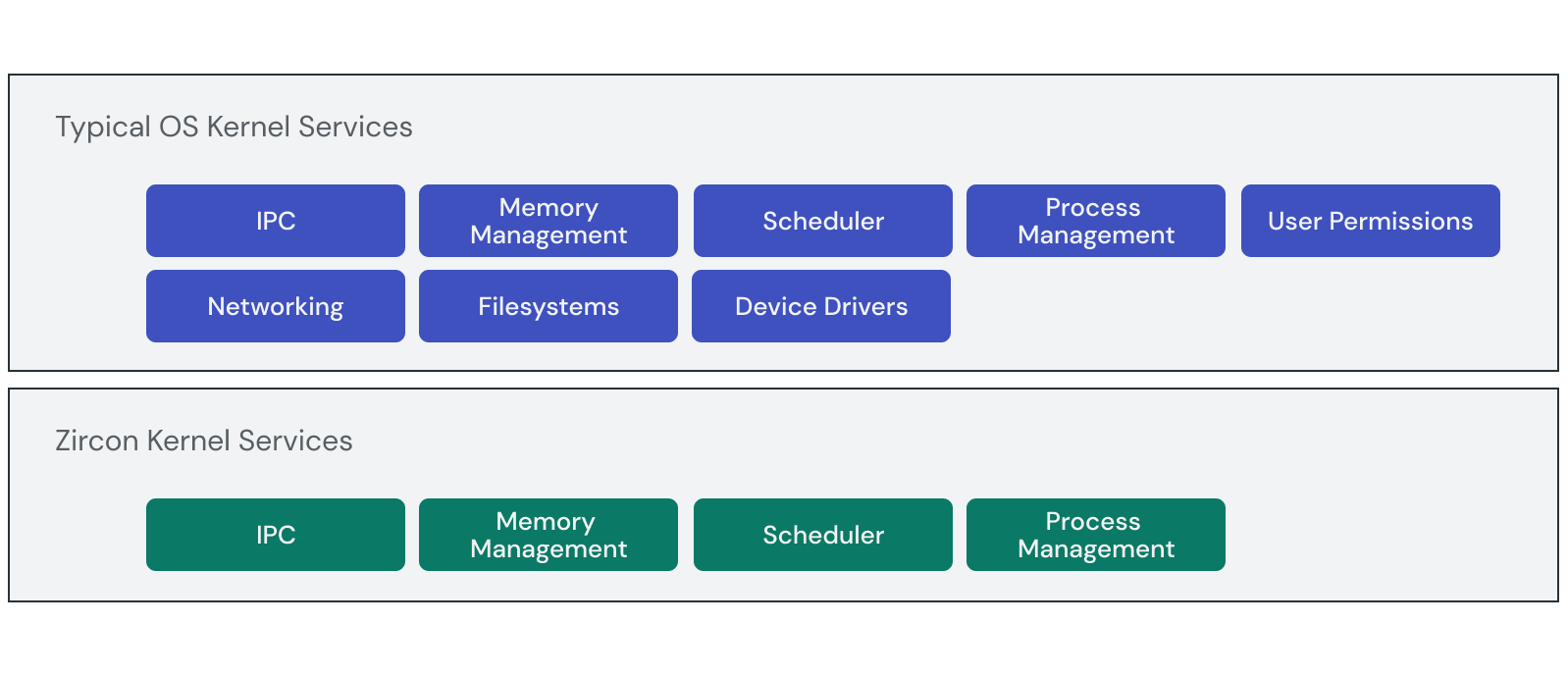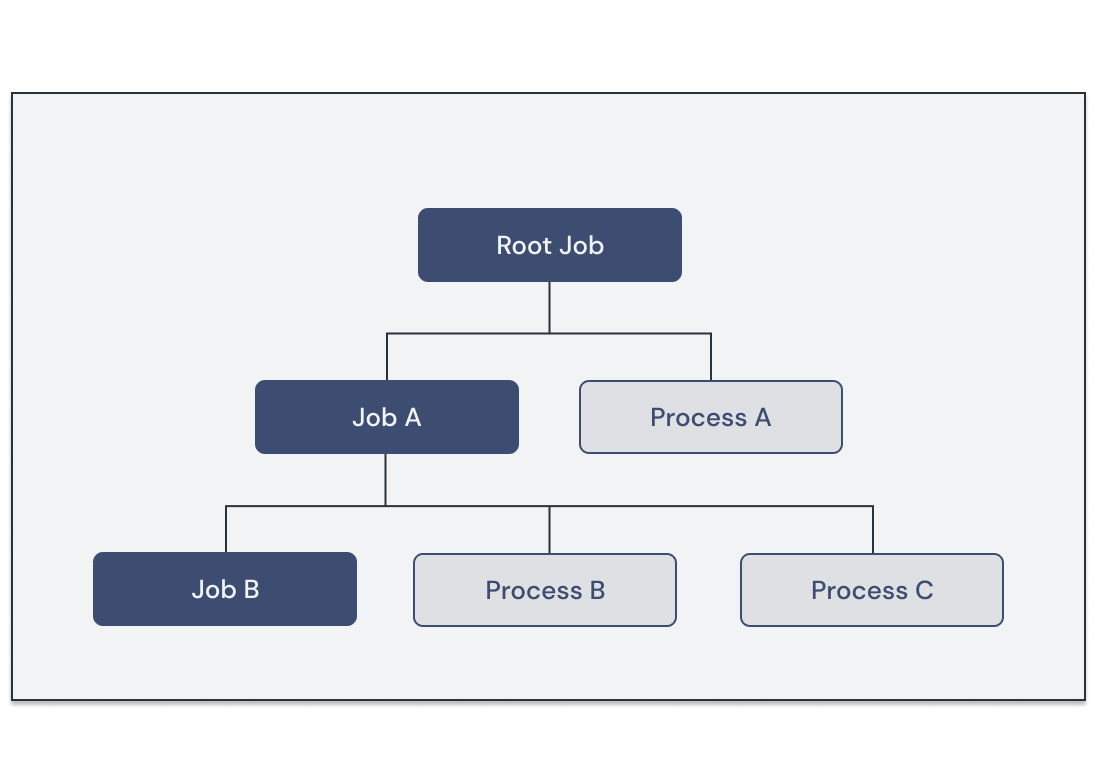Zircon is the core that powers Fuchsia. It is composed of a kernel and a small set of userspace services, drivers, and libraries necessary for core system functions such as booting.
Although Zircon applies many of the concepts popularized by microkernels, it does not strive to be minimal. Instead, the microkernel-like architecture of Zircon enables Fuchsia to reduce the amount of trusted code running in the system to a few core functions:
- Memory management
- Scheduling
- Inter-process communication

System calls
User space code interacts with the objects in kernel space using system calls. Zircon has system calls to perform low-level operations such as:
- Memory management
- Task and process management
- Inter-process communication (IPC) and synchronization
- Exception handling
- Hardware support services (clocks, entropy, device I/O)
User space processes access system calls through libzircon.so — a
virtual Dynamic Shared Object (vDSO)
.
The Zircon vDSO is a shared library in ELF format that the kernel maps into the
address space of each new process. This library is considered "virtual" because
it is exposed directly by the kernel image rather than being loaded from a file.
Most system calls operate directly with one or more
handles
— process-local references to objects living in kernel space represented as a
32-bit integer (zx_handle_t). Each handle declares the privileges, or
rights, the holder has to perform actions on the handle itself or the
referenced object.
Jobs, processes and threads
Zircon exposes three main kernel objects for running code:
- Thread: Thread of execution within a given address space.
- Process: Set of executable instructions run in a private, isolated address space.
- Job: Group of related processes and jobs. All jobs form a single rooted tree.

Processes form the basis for system capabilities. Each process is granted a set of capabilities through the various handles it holds.
Fuchsia software may or may not run within the confines of a single process. Jobs allow "applications" that are composed of more than one process to be controlled as a single entity.
Inter-process communication
Since processes are isolated by default, the kernel needs to provide a way for them to securely communicate with each other. Zircon includes the following kernel object types for inter-process communication (IPC):
- Event: Signaling interface between two processes.
- Socket: Streaming data transport, similar to a pipe.
- Stream: Streaming data transport that is seekable, like a file.
- Channel: Message-based transport capable of passing both data and a set of handles.
- FIFO: Control plane for shared memory access, optimized for small data payloads.
Among these objects, channels are uniquely suited to assist in launching new processes because they are capable of transferring handles (and therefore, capabilities) across to another process.
Channels have exactly two endpoint handles, each owned by a separate process. Only the owners may read or write messages, but ownership of an endpoint may be transferred from one process to another. When handles are written into a channel, they are removed from the sending process. When a message with handles is read from a channel, the handles are added to the receiving process.

Zircon channels are the basis for service-level IPC protocols described by the Fuchsia Interface Definition Language (FIDL) . FIDL protocols are the primary method of IPC used by Fuchsia programs. You will explore creating and consuming FIDL protocols in more detail later on.
Exercise: Jobs and processes
Let's explore some of these fundamental concepts on a running system. In this exercise, you'll see how jobs and processes interact to form a tree.
Start the emulator
If you do not already have an instance running, start the emulator:
ffx emu start --headlessWhen startup is complete, the emulator prints the following message and returns:
Logging to "$HOME/.local/share/Fuchsia/ffx/emu/instances/fuchsia-emulator/emulator.log"
Waiting for Fuchsia to start (up to 60 seconds)........
Emulator is ready.
Dump the process list
Connect to a device shell prompt and use the ps command to dump the list of
running jobs and processes.
fx shell psBelow is a trimmed example of what the output looks like:
TASK PSS PRIVATE SHARED STATE NAME
j: 1027 507.8M 507.4M root
p: 1061 564.4k 564k 36k bin/bootsvc
p: 1150 4264.4k 4264k 36k bin/component_manager
j: 1479 228.4k 228k
p: 1583 228.4k 228k 36k pwrbtn-monitor.cm
j: 1484 532.4k 532k
p: 1599 532.4k 532k 36k svchost.cm
j: 1544 402.4k 304k
p: 1633 402.4k 304k 232k netsvc.cm
j: 1681 296.4k 296k
p: 1733 296.4k 296k 36k console-launcher.cm
j: 1799 7232.4k 7232k
p: 1825 7232.4k 7232k 36k archivist.cm
j: 1927 660.4k 660k
p: 1955 660.4k 660k 36k base-resolver.cm
j: 2072 1016.4k 1016k
p: 2088 1016.4k 1016k 36k driver_manager.cm
j: 2239 348.4k 348k
p: 2252 348.4k 348k 36k device-name-provider.cm
j: 2364 275.3M 275.3M
p: 2380 1012.4k 1012k 36k fshost.cm
p: 6544 252.1M 252.1M 36k /pkg/bin/blobfs
p: 10205 9744.4k 9744k 36k /pkg/bin/minfs
p: 10475 12.8M 12.8M 36k pkgfs
Let's focus on two columns in the output for now:
- TASK: This tells you whether each entry is a job (
j) or process (p) followed by their unique id. - NAME: This provides a little more detail about what piece of the system is running there.
Let's break down some interesting things here based on what we've discussed so far:
- Every process is connected to a parent job. Some jobs have multiple processes.
- All jobs trace back to the
rootjob as the ultimate parent, forming a tree. - During startup, the system launches a few processes directly into the
rootjob. Most other processes are launched under their own parent jobs. - After the initial startup work, many of the entries have a
.cmextension. These refer to components, and you will learn more about them later on. - Some of these components are core services like filesystems (
fshost.cm) and drivers (driver_manager.cm) that live in user space separate from the kernel.
Next, we'll explore how the Zircon enables the fundamentals of Fuchsia's security model.
